By Bus & Rail
The heat is on near new Orange Line
May 31, 2012
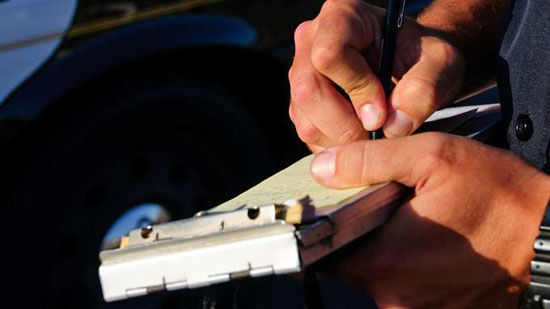
More than 100 tickets have been handed out in advance of next month's Orange Line Extension opening.
Sheriff’s deputies charged with making sure motorists, bicyclists and pedestrians stay safe around the soon-to-open Orange Line Extension have recently handed out 138 tickets—and counting—in the area around the new busway.
Their efforts have intensified recently, as the popular rapid transit bus line prepares to open its new, 4-mile route next month, extending the line from Warner Center to the train station in Chatsworth.
“Just this weekend alone, we did about 40 [citations],” sheriff’s Sgt. Ben Estrada said.
One of the biggest problems: motorists making illegal right turns on red across the busway.
“People are doing that like crazy. They’re ignoring [posted signs] completely, and risking a collision with a bus,” Estrada said.
Others try to beat a changing light but end up partially blocking the intersection—another ticket-worthy infraction.
Then there are those who manage to get into trouble on foot—using the busway as an impromptu running track. So far, deputies have issued only warnings to the joggers.
“They’re getting educated not to be jogging up and down the busway,” Estrada said. “For now, we’re just advising them. They’re not getting cited yet.”
Enforcement efforts have increased as Orange Line buses make trial runs on their new, dedicated busway in advance of an expected June opening. Updated 5/29/12: The Orange Line Extension is set to open to the public on June 30. A day of festivities and free rides is planned. Details are here.
Traffic collisions are not uncommon when new transit lines open, as motorists must adjust to new travel patterns. After the original Orange Line opened in 2005, a series of accidents led officials to convene a special committee to improve safety around the line.
This time around, an aggressive public education campaign is underway, drawing on earlier lessons learned.
Metro “safety ambassadors” have started working near schools in the area, observing pedestrian patterns and helping people navigate crossings.
An advertising campaign is planned for a range of San Fernando Valley publications, and flyers will be placed aboard Metrolink trains and distributed in locations where they’ll reach drivers, such as car washes and gas stations.
And, of course, nothing focuses a motorist’s attention like an expensive traffic ticket. Deputies on motorcycles and in patrol cars are out in force between the line’s Canoga Station, located at 6610 Canoga Ave., and the Chatsworth Metrolink Station, 10047 Old Depot Plaza Road, from now until several weeks after the line opens.
To stay out of trouble, “drive carefully and pay close attention to the signs and the red lights,” Sgt. Estrada advises.
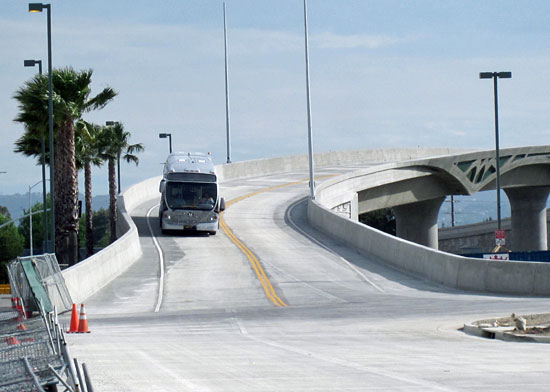
Test runs on the Orange Line Extension are already underway, and so is a new safety campaign. Photo/Metro
Posted 5/23/12
Expo Line’s festive and historic debut
May 2, 2012

The Expo Line rolled into the record books, as the initial phase of the light rail was formally opened on Friday, April 27.
It will run at first between downtown Los Angeles and the La Cienega/Jefferson station, with an opening of the line’s Culver City station planned in coming weeks. The 8.6-mile line was inaugurated with a flourish—complete with tunes from the USC Marching Band, the appearance of huggable T-Rex from the county Natural History Museum, confetti cannons and free rides during Expo’s opening weekend.
Dignitaries including Supervisor Zev Yaroslavsky, chair of the Expo Board, celebrated the historic nature of the occasion, as the first light rail trains since the Red Car made tracks for the Westside. A second phase of the line, which will run to Santa Monica, is now underway.
Posted 5/2/12
Expo’s backstage safety patrol
April 27, 2012
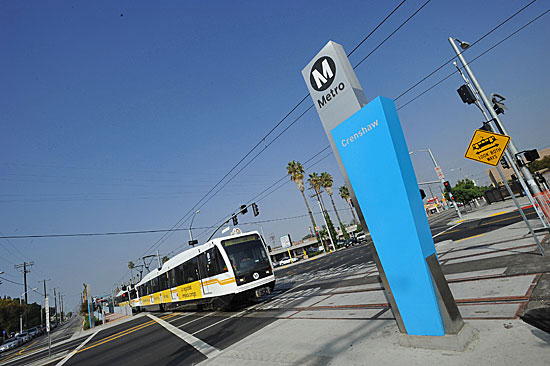
With new Westside rail service, officials want to make sure that trains, cars and pedestrians safely co-exist.
Launch time for the Expo Line means crunch time for Vijay Khawani and Barbara Burns.
With the official opening this weekend of Expo’s first phase, Metro safety and education officials like Khawani and Burns have been working their way down a to-do list that, like the line itself, stretches from downtown to La Cienega.
And then there are the new things that keep cropping up.
Like the guy in the Maserati who ignored flashing signals and almost pulled out in front of an approaching train Tuesday.
Khawani, Metro’s Executive Officer of Corporate Safety, was out on the line with inspectors from the Public Utilities Commission when he spotted the car moving toward the tracks, so he raced down the station ramp toward it, waving his arms and yelling to get the motorist’s attention.
Crisis averted.
Making sure drivers, bicyclists and pedestrians stay alert around the trains—especially while they’re still something of a novelty—is a major preoccupation as Expo gets ready to roll.
Khawani and Burns, manager of Metro’s Transit Safety Education Programs, are key players on a team that must not only ensure that Expo meets all the regulatory requirements but also presents a safe and familiar image to the public in the line’s crucial early days and weeks.
For months, Burns has been deploying a small army of “safety ambassadors”—24 retired bus and rail operators—into communities around the new line to help people navigate the new system and to report back on trouble spots.
“We start one year before any train takes the track,” she said. “In the beginning, it’s always chaotic.”
To educate the public about what’s headed their way, Burns’ team has conducted dozens of training sessions at schools, senior centers and libraries and with neighborhood watch and community groups, sent out hundreds of notices about train testing, put up 4,000 safety posters and handed out 60,000 flyers door to door.
They’ve also placed safety ads on the sides of 20 trains—with bilingual messages such as “Hear bells? See lights? Train’s coming.”
“We started to do it with the Eastside Extension (of the Gold Line) and found it to be very effective,” she said. “It’s like a moving billboard.”
Still, some people don’t get the message. There have been three collisions involving Expo Line trains since testing began—all the result of motorists proceeding against a flashing red light signaling an approaching train, Khawani said. The most recent accident, on April 19, was caused by a driver making an illegal left turn, he said.
“That type of accident is actually the most common type of light rail accident in the industry across the country,” he said. “I think education is a big component because this is something that’s new in the neighborhood. They’ve never had trains.”
Common sense goes a long way, he said. There have been no serious injuries in the Expo crashes, but a brand new Mercedes Benz was totaled on March 19 when its owner got distracted “playing around with the new navigation system,” he said.
“We can’t do it alone,” Khawani said. “They’ve got to obey the signs.”
Large crowds are expected to ride Expo for free on its inaugural weekend, Saturday and Sunday, April 28 and 29. And before the light rail makes its public bow, a series of technical and mechanical fixes have been required.
An automatic routing system to make sure Expo and Blue Line trains—which share some stations in downtown L.A.—get on their respective tracks logged 20 “misroutes” on a recent day of testing.
So at least at the beginning, controllers in Metro’s Rail Control Center (known as “The ROC”) will be routing the trains manually.
“It’s a temporary fix until we can assure ourselves that the automatic routing function is working reliably. It’s not a safety concern, it’s more an operational concern,” Khawani said. “When you’re on a train for Long Beach, you don’t want to end up in Culver City”—an unlikely scenario, he added, because the train operator would almost certainly notice the misroute before reaching the end of the line.
Another major priority is making sure that trains don’t block intersections. That has meant getting the city Department of Transportation to change signal timing to give train operators some extra “green time” to proceed through intersections—first 10 extra seconds and then, as of Sunday, 4 more.
“Four seconds make a big difference,” Khawani said. “Since Sunday, we have not seen any trains blocking any intersections. It has improved it dramatically.”
A test run Tuesday with the PUC inspectors onboard was largely successful, although two signs at the Crenshaw station needed to be relocated so trains can proceed without getting stopped between stations.
At the La Cienega station, Khawani checked to see that emergency lighting required by the L.A. Fire Department was in place and working. (It was, and he snapped a photo with his phone.)
No detail, it seems, is beneath his attention. He called in a mistake he spotted at the Western station, where a pavement sign reading “Stay Behind Yellow Line” was accidentally transposed to read “Yellow Line Stay Behind.”
Animated but apparently unflappable, Khawani has seen 20 years’ worth of launches since he joined Metro. And he says he has never doubted that the Expo Line would open Saturday.
“This is very typical of all openings,” he said. Still, don’t expect him to let his guard down anytime soon. “I don’t think there is ever a time when you get to breathe a sigh of relief.”
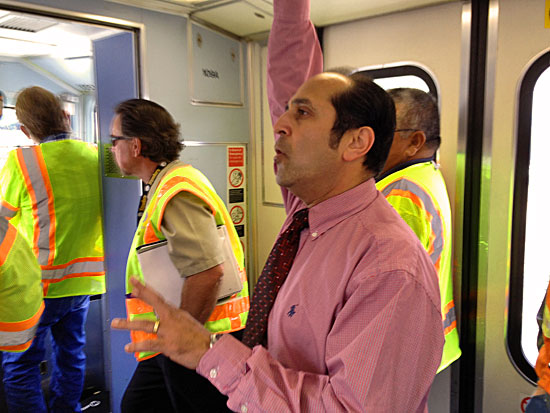
Vijay Khawani, Metro’s Executive Officer of Corporate Safety, rides Expo with safety team and PUC inspectors.
Posted 4/26/12
Subway makes tracks toward Westwood
March 23, 2012
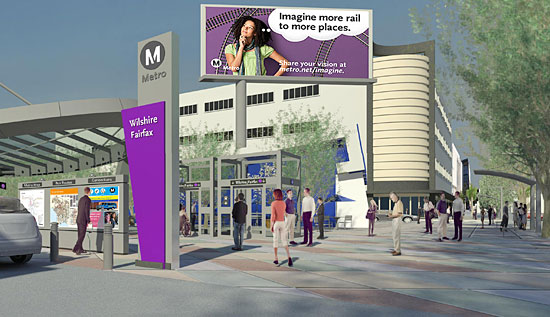
The subway's 7 proposed stations, most along Wilshire, could look something like this, at Fairfax near LACMA.
Metro officials today unveiled final environmental documents for the Westside Subway, detailing a 9-mile extension of the existing Purple Line subway with seven recommended stops, including a Century City station at Constellation Boulevard and Avenue of the Stars—a location approved by a panel of top scientists but hotly contested by some officials in Beverly Hills.
The release of the final environmental reports marks a significant milestone for the project, which has been in the planning stages for more than four years. When completed, the subway is expected to log 78,000 trips a day and make it possible to travel from downtown L.A. to Westwood in 25 minutes.
While the project will benefit riders throughout the region, its impact will be felt most strongly on the Westside, which has a heavy concentration of jobs along with some of the worst traffic in the nation.
“This is a project that Los Angeles has been talking about for at least a half a century,” said Jody Litvak, Metro regional communications manager. She called the release of final environmental documents “a huge accomplishment” and a “delivery to voters on the promises of Measure R,” the ½-cent sales tax that will partially fund the subway.
The Westside Subway would begin where the Purple Line currently ends, at Wilshire and Western. The new stations would be located along Wilshire at La Brea, Fairfax, La Cienega and Rodeo Drive, as well as in Century City, at UCLA and at the V.A. Hospital.
The siting of the Century City station has been controversial. Because the route to get to the proposed Constellation station would pass under the Beverly Hills High School campus, some city officials have raised safety concerns about tunneling in the area and urged that the Century City station be built instead under Santa Monica Boulevard.
But last year, a panel of high-profile scientific experts convened by Metro said that active earthquake faults make the Santa Monica Boulevard location too dangerous for a subway station. These experts, including Lucy Jones of the U.S. Geological Survey and Caltech, found instead that a station could be safely built at the Constellation site, which has no evidence of active faults. In addition, they said that tunneling under the high school property could be accomplished safely with state-of-the-art equipment and techniques even through earthquake zones and ground with large concentrations of methane gas.
Beverly Hills hired experts of its own to review Metro’s scientific conclusions. Those experts argue that more research is needed, particularly around the Constellation site and on the high school campus. (The city’s website has links to those reports, as well as other information on Beverly Hills’ position on the subway.) In addition, the Beverly Hills school board recently commissioned widespread trenching studies on the high school campus to determine whether seismic hazards are present; a report on that is expected soon.
Metro officials say the final environmental documents released today make it clear that it will be safe to build a subway station at Constellation, but said they will be studying the Beverly Hills reports carefully. (Updated: The Beverly Hills School District’s attorney, Kevin Brogan, issued a statement criticizing Metro for releasing the final environmental documents before receiving the results of the trenching studies. His statement is here.)
Agency officials said the Constellation station also would attract more riders and be closer to more jobs than the Santa Monica Boulevard station. The agency projects 8,600 boardings at Constellation each weekday, compared to 5,500 boardings at Santa Monica Boulevard.
The final environmental reports also studied various alternatives for the two stations in Westwood. For the UCLA station, the report recommends a location on Wilshire at Westwood Boulevard. At the V.A. Hospital, it recommends building the station on the south side of Wilshire at Bonsall Avenue, in the northern edge of the hospital’s parking lot just west of the 405 Freeway.
Plans call for the subway to get to Wilshire and La Cienega by 2020, to Century City by 2026 and to the Westwood V.A. Hospital by 2036. However, some officials, including Metro Board Chair and Los Angeles Mayor Antonio Villaraigosa, are pressing for the entire project to be completed much sooner—by 2022—under an accelerated building program known as America Fast Forward.
Metro has estimated the cost of the project at $5.66 billion in 2022 dollars, but that could rise to an estimated $6.29 billion if the project takes until 2036 to complete. Some funding will come from Measure R but more will be needed from the federal government’s “New Starts” program.
The final environmental documents are scheduled to go before Metro’s Board of Directors on April 26. If the board votes to certify the project, the Federal Transit Administration will be asked to sign off on the plans and formally conclude the federal environmental review phase of the project. Then, final design work is expected to take about a year, with groundbreaking slated for sometime in 2013.
A series of informal community open houses are scheduled next week so that people can learn more about the project and see artists’ renderings of what some of the stations could look like. They will be held on Monday, March 26, at the Los Angeles County Museum of Art; on Wednesday, March 28, at Westwood United Methodist Church; and on Thursday, March 29, at Temple Emanuel in Beverly Hills. Each of the meetings will run from 5 p.m. to 7:30 p.m. Additional details and parking information are here.
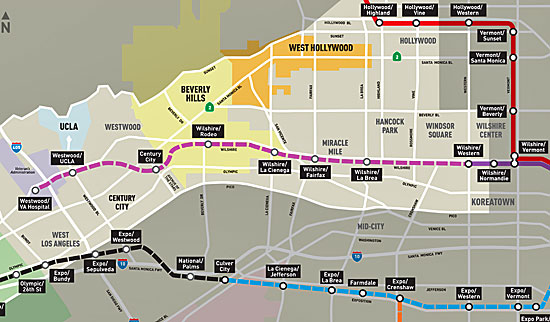
The 9-mile extension of the Purple Line starts at Wilshire and Western and ends at the VA Hospital in Westwood.
Posted 3/19/12
It’s a date: Expo to roll in April
March 23, 2012
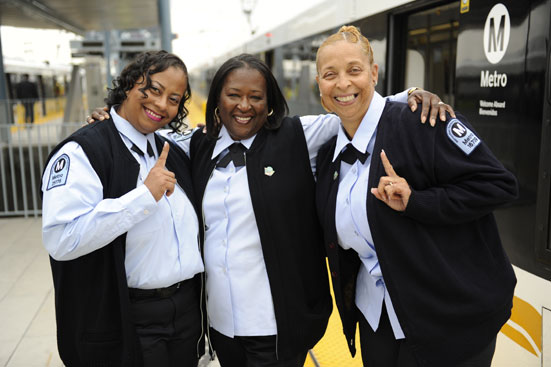
Train operators are ready to roll. From left, Narvolean Jackson, Carolyn Kelly and Sheila Celestain. Photo/Metro
After months of testing and delays, the much-anticipated Expo Line light rail will start carrying passengers on April 28, officials announced today.
Riders will be able to jump aboard for free during the line’s inaugural weekend, April 28 and 29. Metro Board Chair and L.A. Mayor Antonio Villaraigosa announced the opening this morning at a news conference with Supervisor Zev Yaroslavsky, Exposition Authority chair and Metro board member, and Metrolink chair Richard Katz.
“Some of us didn’t think we’d live long enough to see this day, but we’ve made it,” joked Yaroslavsky, standing on the platform of the new station at La Cienega and Jefferson. “This is the first light rail line, mass transit line, to serve the Westside of Los Angeles since the Red Car was dismantled in the 1950s, so this is a huge deal.”
After the announcement, the elected officials, Metro staffers and members of the news media hopped aboard Expo Line Train 246 for a standing-room-only ceremonial trip from La Cienega to downtown.
At first, the new line will run from Metro’s 7th Street Center downtown as far as the La Cienega station. Paralleling the notoriously jammed 10 Freeway, the Expo Line will open with 9 new stations, including USC, Western, Crenshaw and La Brea, and two stations shared with the Blue Line. In coming weeks, an additional station in Culver City is expected to open at Venice and Robertson, concluding the 8.6-mile Phase 1 of the project.
Meanwhile, Phase 2 is underway to extend the line 6.6 miles to 4th and Colorado in Santa Monica; it is expected to be completed in four years.
This interactive map shows how the entire 15.2-mile line will look when finished. It’s expected to eventually carry about 64,000 passengers a day, making it one of the most heavily-used lines of its kind in the country. The first phase is projected to carry about 26,000 riders a day.
“Every time we add a leg to our regional transportation network, it’s a whole that is bigger than the sum of its parts,” Yaroslavsky said. “When we finish this line to Santa Monica, you’ll be able to go from any part of Southern California to the beach. People who live near the beach will be able to go to any other part of Southern California. This line will now connect this community—the Crenshaw area, the Culver City area, ultimately Santa Monica—to the rest of the region.”
Testing on the $932 million first phase of the Expo Line has been underway since last fall, but the opening has been delayed several times to work out technical and logistical issues, including signal timing where the line intersects with the Blue Line at Washington and Flower.
Metro CEO Art Leahy said that problem has recently been worked out to allow trains to move through the intersection at regular intervals, without causing delays that could have rippled out throughout the system.
The Expo Line’s opening comes against a backdrop of rapid expansion of Los Angeles’ public mass transit network, once widely—and justly—derided as close to nonexistent.
In addition to the upcoming opening of the first part of the Expo Line, work has begun on the $1.5 billion Expo Phase 2, the northward extension of the Orange Line is nearly complete, final environmental documents for the Westside Subway have just been released and the Gold Line is expanding to Azusa, among other projects.
“There’s no city in the country, none, that is engaged in as ambitious an expansion of their light rail and subway system than L.A.,” Villaraigosa said.
Officials credited county voters will making it all possible by approving Measure R, the ½-cent sales tax for transit projects, in 2008.
“These are your tax dollars at work,” Yaroslavsky said.
Posted 3/23/12
For a preview of what’s in store, check out Supervisor Yaroslavsky’s Expo Line test ride in this video.
Bowl rides go up, but not for all
January 24, 2012
Concert-goers planning to use the Hollywood Bowl’s popular park-and-ride service this season, take note:
Buy your park-and-ride tickets in advance and you’ll pay the same $5 roundtrip fare that’s been in effect since 1995.
Those who wait to purchase their tickets at boarding time won’t be quite as fortunate.
The Board of Supervisors on Tuesday approved the first fare increases for the program since 2009. Roundtrip park-and-ride service will go from $8 to $10 for those who purchase at the park-and-ride lots. Roundtrip service from four shuttle lots—two on Ventura Boulevard and the others at Hollywood and Highland and the L.A. Zoo—will increase from $4 to $5.
In either case, patrons will avoid the Bowl’s famously tough stacked parking and will be able to travel with a clear environmental conscience in buses powered by clean diesel or alternative fuels.
And they’ll be in good company. Ridership on the park-and-ride and shuttle programs hit a 10-year high during the 2011 season, with nearly 31% of all patrons using the service. In all, patrons from all over the county logged 422,612 one-way trips by shuttle and park-and-ride last year.
Posted 1/24/11
Changes coming for Orange Line riders
January 11, 2012
Metro’s Orange Line Extension is well on its way to improving transit options in the western San Fernando Valley and beyond. As construction continues, however, some current riders on the rapid transit busway will have their stops temporarily relocated in the days ahead.
From January 18 to January 30, the Pierce College, De Soto and Canoga Stations will move one block south, along Victory Boulevard. Ticket sales and parking will still be available at the original stations, but patrons should allow extra time to walk to the temporary stops, where tickets will not be sold.
The Orange Line Extension is currently ahead of schedule and under budget. It is expected to open two months early in June with a final price tag of about $180 million, substantially less than the $215.6 million budgeted for the project.
Once the four-mile extension is completed, it will stretch from Canoga Park to the Chatsworth Metrolink Station, improving north-south mobility in the San Fernando Valley and linking with Amtrak and other regional transit providers.
Posted 1/11/12
Ticket sales rise when subways locked
November 17, 2011
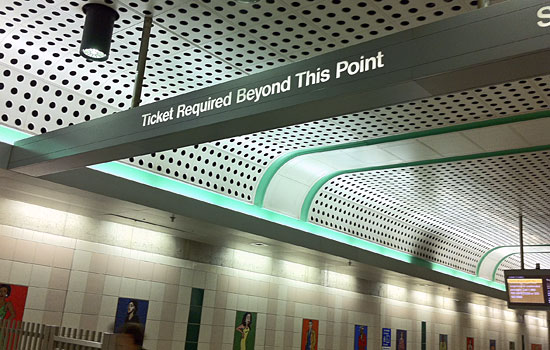
With Metro testing locked subway turnstiles, signs like this one in the Civic Center station take on new importance.
As thousands of L.A. subway riders have learned in recent weeks, honesty is the best policy—especially when somebody’s watching to see whether you paid to ride.
Recent testing to determine the financial impact of locked turnstile gates at four stations, including ticket checks by uniformed inspectors, boosted vending machine sales of day passes and one-way fares by about 50% while gates were locked.
“It was apparent many customers were using [ticket vending machines] for the first time,” according to a report to the agency’s Board of Directors.
As ticket sales went up, overall station entries decreased by 10% during the testing period as some travelers were apparently deterred by the locked gates and presence of ticket-checking staff.
Nevertheless, vending machine revenue was up 35%, the report said. Over time, as customers became accustomed to locked gates, that boost could be expected to level off, perhaps settling around 20%.
The gate-locking trial run also has had financial implications for the traveling public; dozens have been hit with citations carrying fines of up to $250 for riding without a ticket or pass.
The testing comes as Metro continues moving away from its original honor-system approach on the subway toward the locked turnstile set-up common in other large cities such as New York and San Francisco.
The conversion started in 2008, when Metro’s board approved a 10-year, $46 million lease contract to retrofit the Red Line, the Purple Line and some light rail stations with barrier gates—both as a security measure and as a way to recoup lost revenues estimated at the time to be about $5.5 million a year.
Since the gates were installed, however, some have questioned whether the cost of monitoring a locked subway system would outstrip any gain in revenues.
The report did not specifically address that issue, but said the preliminary revenue findings were “quite positive.”
More testing is needed, the report said, to see if patterns hold true when gates are locked during peak travel hours, from 1 p.m. to 6 p.m. To that end, a new round of locked-gate testing started Oct. 26 and is expected to continue through January 11, 2012. Upcoming stations targeted for the tests are UniversalCity, North Hollywood, Hollywood/Vine, Civic Centerand 7th/Metro.
In conjunction with the locked gate testing, Metro is heavily promoting use of its TAP cards, which can serve either as transit passes or as stored-value cards from which funds are deducted each time they’re used. The TAP cards aren’t just quick and convenient for riders; they also enable the agency to keep better track of ridership and ensure that everybody’s paying their way.
But there are challenges because some 40% of riders surveyed did not use the cards, or had transferred from other transit agencies that are not yet part of the TAP system.
Even among the 60% of customers with TAP cards, there were issues.
Up to half did not tap their pre-paid cards unless “encouraged” to do so, the report said. And when the turnstiles were in their usual “free-spin” mode, only 25% bothered to tap.
Posted 11/17/11
Gaga for night trains
November 8, 2011
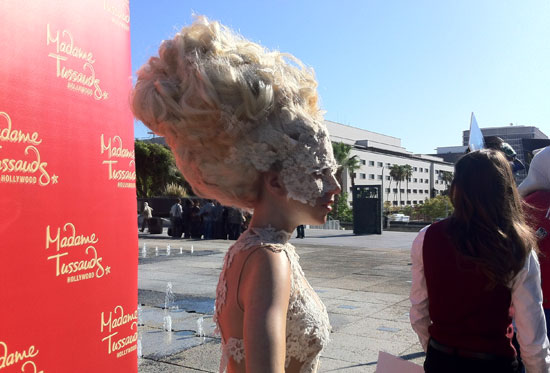
A faux Lady Gaga and a contingent of real celebs showed up to promote Metro's new ridership initiative.
Whether your taste runs more to seeing an incredibly lifelike Lady Gaga at Madame Tussauds or to swimming with sharks at the Aquarium of the Pacific, Metro has a holiday season gift for you—more frequent night trains to popular Los Angeles County destinations starting Sunday, November 13.
Metro’s board chair, Los Angeles Mayor Antonio Villaraigosa, announced today that the agency’s busiest rail lines—the Red and Purple line subways and the Blue Line light rail—will be stepping up their service between 6 p.m. and midnight. Trains will run every 10 minutes or so—double the current frequency—thanks to a trial program that involves running shorter trains more often.
If it’s successful, the program may be extended to other lines next year.
The night trains were announced at a news conference at the Music Center attended by representatives of arts, sports and entertainment venues—including a teenaged cellist and violinist from the Colburn School, a scuba-suited aquarium board member and the L.A. Kings’ mascot, along with that realistic Lady Gaga mannequin.
The new night service coincides with a series of discounts being offered at an array of participating venues. (Click here for more information.)
To make sure the trains are safe, Villaraigosa said more sheriff’s deputies have been brought in recently, and added that crime on the system overall has declined about 5%.
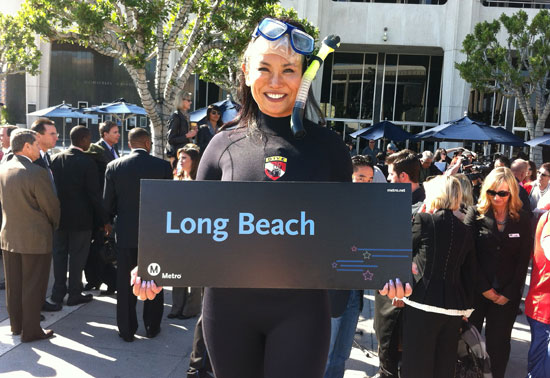
Patricia Wang of the Aquarium of the Pacific in Long Beach encourages night visits via the Blue Line.
Posted 11/8/11




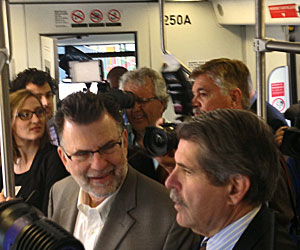
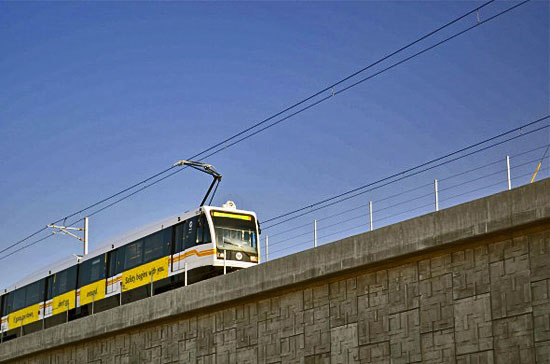
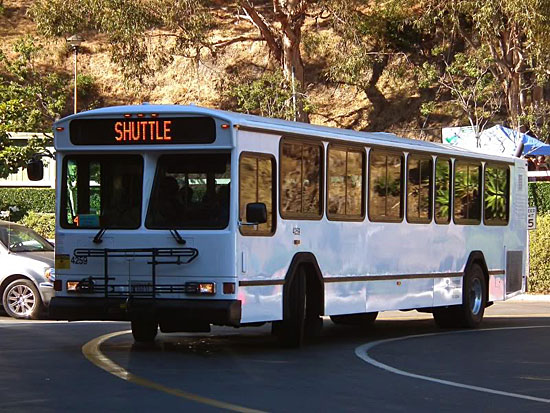








 405 bridge work causes a stink
405 bridge work causes a stink

